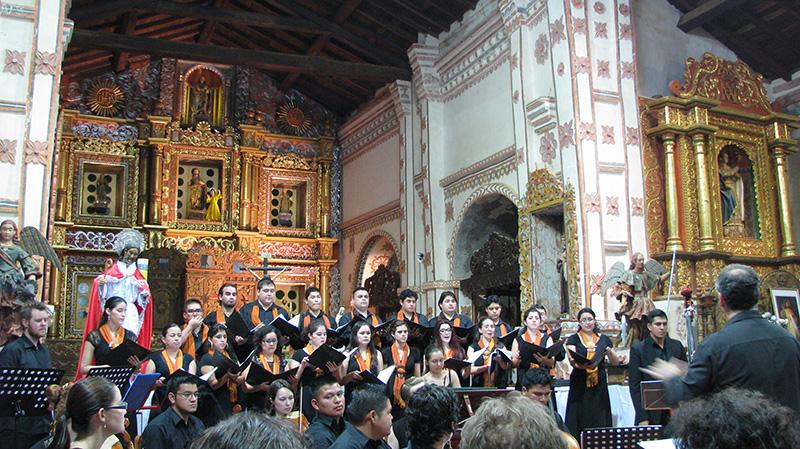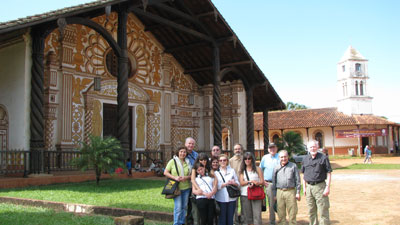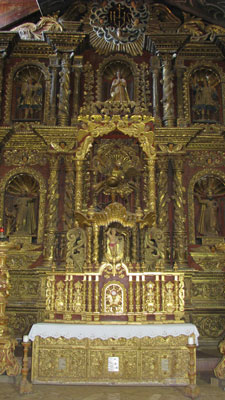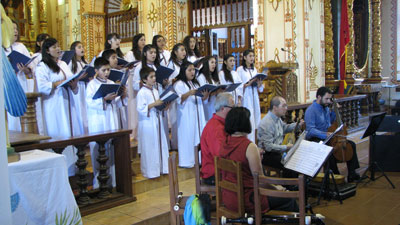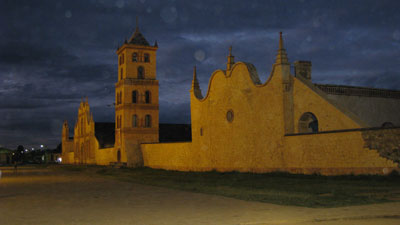Enjoying the glorious sounds of Bolivia’s International Festival of American Renaissance and Baroque Music
This article appears on page 6 of the June 2015 issue.
My partner, Arcadio, and I departed Los Angeles on April 15, 2014, for Santa Cruz de la Sierra, Bolivia, as guests of my dear “adopted brother” Pepín Orlando Jordán and his lovely wife, Blanca.
I had met Pepín in San Ignacio in 1966, where he had gone to study in the colegio run by the priests at the old mission there and where I was working as a Peace Corps Volunteer. I was renting a room in the house where he lived.
Pepín made arrangements for the four of us to attend the 2014 International Festival of American Renaissance and Baroque Music, held every two years during the months of April and May in the Department of Santa Cruz, with performances held mainly in the misiones de Chiquitos (missions of Chiquitos). During our 7-day tour, we visited seven missions, all venues used during the festival.
The tour
A fortunate choice was made by Pepín in using Misional Tours (Santa Cruz; phone +591 3 360 1985, www.misionaltours.com) as our tour operator. Not only was our modern coach very comfortable, our hosts, Mercedes (guide) and Luis (driver), were exceptionally attentive to our needs.
There were 14 compatible members in our group, and we all spoke Spanish. The per-person cost was $800.
Chiquitos comprises six of the remaining reducciones de indios (settlements of Christianized Indians) founded by the Jesuits between 1696 and 1760. Following their restoration, the missions of Chiquitos became, in 1990, the UNESCO World Heritage Site known as the Jesuit Missions of the Chiquitos. They include San Francisco Xavier, Concepción, Santa Ana, San Miguel, San Rafael and San José de Chiquitos.
Because they were constructed of very hard native woods and because the Chiquitanos continued to worship in them, these Jesuit missions were not destroyed after the expulsion of the Jesuits from Latin America in 1767.
During restoration of the mission, begun in 1972, thousands of pages of music written during the 17th and 18th centuries by European and indigenous composers were recovered.
These missions embody a living heritage and, since 1996, have been the principal missions where this music, as interpreted by international and Bolivian ensembles, has been played, in the same locations it was performed three centuries before.
Santa Cruz to Concepción
We began and ended our tour in the capital city of Santa Cruz de la Sierra, which has grown to be a chaotic city of two million inhabitants. Without much in the way of urban planning, the city suffers from stifling traffic but has a modern airport. (In 1966, the city had not one paved street, giving it the nickname “Santa Cruz de la Tierra” or “Santa Cruz of the Dirt.”)
Pepín set up some visits during our free time there, and we spent our first nights next to the cathedral in Hotel Misional, constructed in mission style but with Wi-Fi and television. As Holy Week was ending, we were able to attend the processions that were being held in the city.
On our first day out we traveled to Concepción, with a stop in San Xavier for lunch and to visit the beautiful mission church there. En route we saw fields of soybeans, sorghum, sunflowers and cotton.
The first Jesuit mission in Chiquitos, constructed between 1749 and 1752, the church of San Xavier is a wood-and-adobe structure built in Baroque style, with a beautiful tile floor and an altar replete with retablos (altarpieces). Cherubs, seraphs and santos cover the interior. Outside, there is a fine campanario (bell tower).
Unfortunately, no concert was scheduled in San Xavier until the evening, at which time we would be in Concepción.
Our overnight stop was a very comfortable hotel in the mission style, Hotel Chiquitos, situated on five acres, with subtropical birds and plants, especially orchids.
After check-in and a rest, we went to Concepción’s mission church for our first concert, performed by Música Fiorita and Coro Martín Schmid. It was a collaboration between Swiss musicians and conductor and a Bolivian choir. As a preformed group, we were given priority seating near the musicians. It was a splendid concert, but better ones lay ahead.
After the concert, we enjoyed a buffet dinner at our hotel. As a group, we opted to follow the Latin American tradition of dining late. All meals were included once we departed Santa Cruz.
Plentiful buffets were the order of the day, and we often enjoyed local breads made with manioc flour and cheese, called cuñapés, as well as cheese empanadas and tropical fruits. Why is it that when you travel, your clothes seem to shrink?
The next morning we revisited the church of Concepción, designed by the Jesuit priest Martín Schmid (as in the choir’s name). Work began on the church in 1752, once more reflecting the Baroque style. It features three naves, rows of sculptured wooden columns and altars with retablos and paintings by the local Chiquitanos.
Called the “jewel of Chiquitos,” the church is arguably the most beautiful of the mission churches. At a glance, the artistic splendor achieved by the Jesuits, both inside and outside, is evident. At sunset, however, the view is unforgettable!
On to San Ignacio
As we left Concepción, we also left the paved road behind, driving three hours on red dirt to reach San Ignacio de Velasco, the largest town in Chiquitos, its having grown from 5,000 inhabitants in 1965 to 40,000 in 2014.
When I worked there with the Peace Corps, the main mode of transportation was a weekly flight from Santa Cruz, and it created quite a buzz when the DC-3’s engines were heard. We all would scurry to the landing strip to see who was arriving or if we had received a package.
The town’s plaza is famous for its pregnant-looking toborochi, or silk floss, trees, with their pink flowers. We found the people in this area very friendly.
San Ignacio is a good spot for visiting three other mission towns, San Miguel, San Rafael and Santa Ana, each about an hour away. It also has several excellent workshops that produce Chiquitano art.
Since I lived there, some Soviet-style monuments have crept onto the landscape, including one opposite the cathedral.
We stayed two nights at the excellent Hotel La Mision, located on the plaza and a stone’s throw from the cathedral.
In my Peace Corps days, this site was where my colleague, Sabina, and I took meals with Doña Carolina. About 15 years ago the hotel replaced our pensión — a good move.
San Ignacio was founded in 1748 by the Jesuits, but the present-day church dates from 1972 and is the fourth one on this site. The Chiquitanos deemed the third one a monstrosity; fire destroyed the first two.
The town is home to the diocese, and this new church is the largest in Chiquitos, but it holds few relics from the Jesuit past. Ergo, it is not a World Heritage Site.
Our first concert in the cathedral featured music by Tokyo Baroque — a somnolent evening. In the morning, Mercedes showed us the environs of San Ignacio before a morning concert by the Coro de Alumnos SIP Red de Colegios, a choir from Chile. These were students who interpreted music written by missionaries in Chile; they had been invited to give four concerts during the festival.
This concert was most enjoyable!
Heading south
After lunch at Club Social, where we always danced in the ’60s, we headed south one hour to visit the mission churches of San Miguel de Velasco, San Rafael de Velasco and Santa Ana de Velasco, all of them World Heritage Sites.
Of all the restored Jesuit churches we saw, San Miguel’s stunning church, built in 1752, is the one that most closely matches its original form. The sirens at the base of the beautiful pulpit caught my attention.
This active mission is one of the most photographed, and it has its own orchestra.
Another short, bumpy ride took us to San Rafael de Velasco, where we visited the second mission to be built in Chiquitos. It is one of those little towns where time seems to have stopped, but it has its own beautiful Schmid-built church, the first to be restored by the late Swiss architect Hans Roth, beginning in 1972.
Santa Ana de Velasco’s church also looks much like it originally did. It was actually built after 1767 (when the Jesuits were expelled) by the local people.
That evening we attended a heart-rending performance by the mission orchestra, Orquesta de Cuerdas Santa Ana, a string orchestra made up primarily of violinists who played instruments made locally.
In the choir loft is the only original (though restored) organ left in any Chiquitano church, dating from 1750. The caretaker, Don Lucho, allowed me to play a bit of Bach for the group! The organ sounded like a calliope, but was loud like a Wurlitzer.
Some of the tour members were anxious to return to San Ignacio to be sure to arrive in time for the fine evening of music that was in store, performed by the ensemble L’Harmonie des Saisons from Canada. They were quite correct that this concert was not to be missed. This ensemble, with its American conductor, really stole the show and offered up several encores of Baroque music.
San José de Chiquitos
It was a long, bumpy road, feeling like a washboard due to the heavy rains that year, to San José de Chiquitos, our final mission.
We spent one night at La Casa de Mamá, a “boutique hotel.” My room was comfortable, though the bathroom was dark (perhaps a flashlight would be helpful), but breakfast was the best, offering eggs to order and salteñas (meaty empanadas).
San José de Chiquitos was the third Jesuit mission in Chiquitos, located in the middle of this town of some 12,000 inhabitants. Its walls were made of stone, not wood like the other missions. It did not fail to impress, but it is in need of more restoration.
As in the other mission churches, the dominant colors used were yellow, coffee, ochre and black.
In the afternoon we visited the museo misional, fronted by a lovely plaza with white silk floss trees. The seeds of these trees are tasty morsels, apparently, for toucans, which we saw the next morning.
At 8:30 p.m. a wonderful concert took place in the church, bringing together a Bolivian choir of Guaranís, the Nordic Brass Ensemble from Norway and the British conductor Ashley Solomon from the Royal College of Music. Five songs in the Guaraní language were sung, evoking the music of the movie “The Mission.”
This fine musical evening was a highlight and the perfect ending to the festival’s offerings for our group.
The church was packed, and the locals were listening at the windows. (There was even a father with a sleeping infant perched in a window near us.) Nobody wished the concert to end, but, finally, Maestro Solomon said, “Uno más” (“One more”), and it was over.
If you go
The next International Festival of American Renaissance and Baroque Music will be held during the months of April and May in 2016. That will be autumn in Bolivia, beginning just as Holy Week ends. Visit www.festivalesapac.com for more information. Companies offering English-speaking guides are available, of course.
As the festival grows, expect the unexpected.
The Department of Santa Cruz can be a little humid and rainy, but it is subtropical. Only bottled water should be drunk.
Visas to enter Bolivia are required of US passport holders at a cost of $160 per person. Bolivian consulates will provide visas, but we saw, on arrival in Santa Cruz, that if you had no visa, it could be purchased upon arrival.
We were vaccinated against yellow fever before our trip, though we were never asked to show proof.
I will be happy to answer queries C/O ITN.

